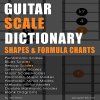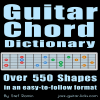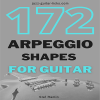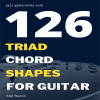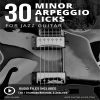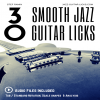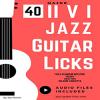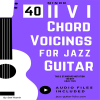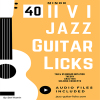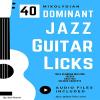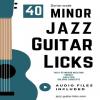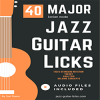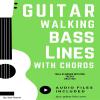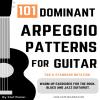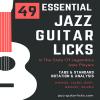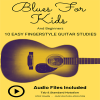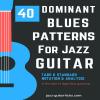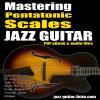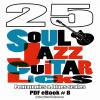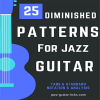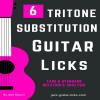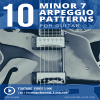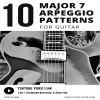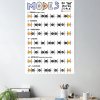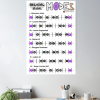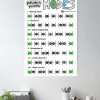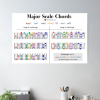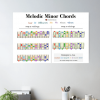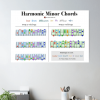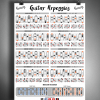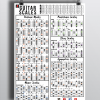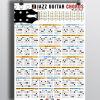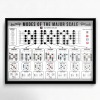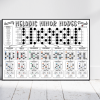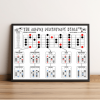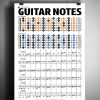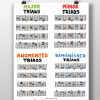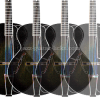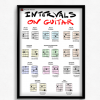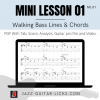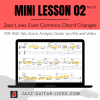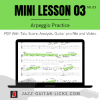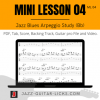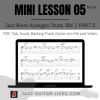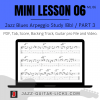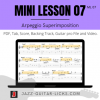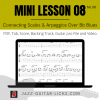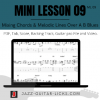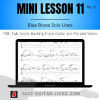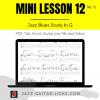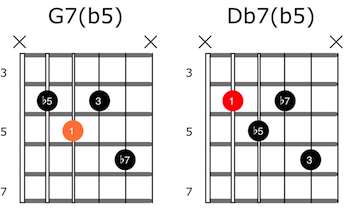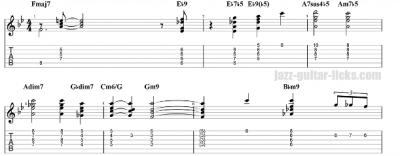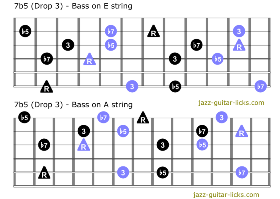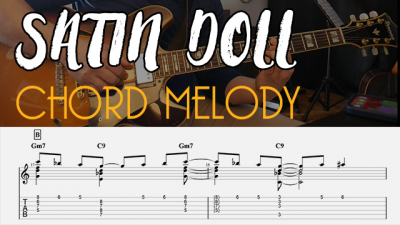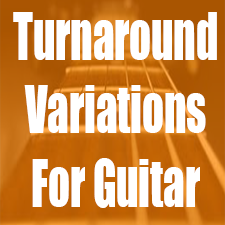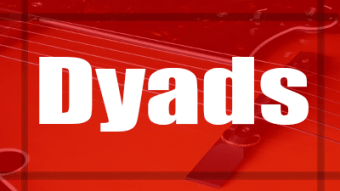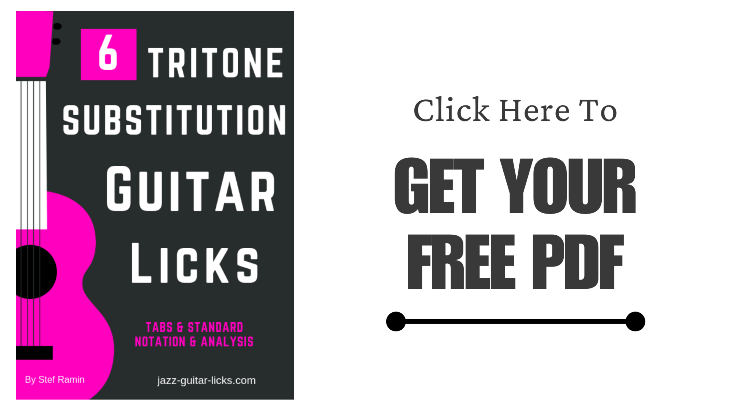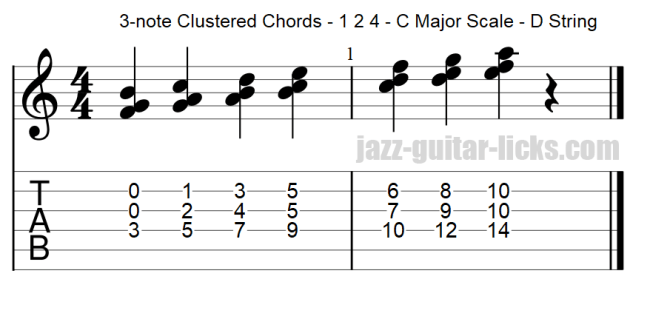
Cluster Chords On Guitar - Theory And Exercises With Tabs
- By jazz-guitar-licks
- On 2020-08-19
- 2 comments
This guitar lesson with tabs and theory is about cluster chord voicings.
These are chords in which at least two notes are grouped together in order to create a sort of dissonance.
Cluster chords are sometimes quite difficult to play on guitar but they have a very interesting sound widely used in comtemporary jazz and neo-soul music.
What Are Cluster Chords?
Theoretically, a cluster is built when adjacent tones of a scale are played at the same time.
Cluster chords contains three or more notes bunched together, these notes are 1 or 2 semitones apart.
The result is a modern sound, slighly dissonant in certain situations.
Cluster chords are quite easy to play on piano cause the notes are close to each other therefore, piano players can play more than three notes.
That is not the case for guitarists indeed, playing more than three notes requires to stretch the fingers.
That's the reason why this lesson is about three-note chords only.
3-Note Cluster Chord Construction
First lets' take see how three-note clustered voicings are built.
There are two main versions here they are :
The first one is built with root (1), third (major or minor) and fourth which is 1 or 2 semitones from the third. Formula is 1 - 3 - 4.
The tab below show the position for 3-note C major chord. It is made of C (root), E (3) and F (fourth). It can be named C major add11.
The second is made of root, second (major or minor) and fourth.
These three tones are distant 1 or 2 semitones from each other. The formula is 1 - 2 - 4.
The exercise below show how to play a clustered 3-note in C.
Seventh Chord Clusters
It is possible to create 3-note clusters including a seventh. Here are two options :
Starting from the third we get : third (minor or major), seventh (major or minor) and root (1). Interval pattern is 3 - 7 - 1.
Here is how to play it on guitar.
Starting from the seventh we obtain : seventh (major or minor), root (1) and third (major or minor). Pattern is 7 - 1 - 3.
You will notice that there no fifth in these two voicings.
3-note Cluster Chords From The Diatonic Major Scale
Now let's built 3-note clustered chords from each note of the diatonic major scale (C major for the example) starting on the 4th and 3rd string of the guitar.
Chord Clusters - Formula 1 3 4
The progression below starts on the degree I (C).
Each degree of the major scale is harmonized by stacking a third and a second:
- The first chord is built by with a major third (C-E) and a minor second (E-F).
- The chord of the degree II (Dorian) is built with a minor third (D-F) and a major second (F-G).
- The third chord is built with min3rd (E-G) + 2nd (G-A).
- Fourth chord : maj3rd (F-A) + 2nd (A-B).
- Fifth chord : maj3rd (G-B) + min2nd (B-C).
- Sixth chord : min3rd (A-C) + 2nd (C-D).
- Seventh chord : min3rd (B-D) + 2nd (D-E).
The following sequence starts on the fourth chord of C (F Lydian).
Chord Clusters - Formula 1 2 4
This 3-note chord cluster implies stacking a second and a third on each note of the diatonic major scale.
This voicing highlights the 9 and 11 of each chord :
- Degree I : 2nd (C-D) + min3rd (D-F).
- Degree II : 2nd (D-E) + min3rd (E-G).
- Degree III : min2nd (E-F) + Maj3rd (F-A).
- Degree IV : 2nd (F-G) + maj3rd (G-B).
- Degree V : 2nd (G-A) + min3rd (A-C).
- Degree VI : 2nd (A-B) + min3rd (B-D).
- Degree VII : min2nd (B-C) + maj3rd (C-E).
Here are the same chords starting from F on the fourth string.
Chord Clusters With Seventh - Formula 3 7 1
The next four progressions are made of 3-note clustered chords (key of C) including a seventh.
The formula 3 7 1 implies stacking a fifth and a second on each note of the major scale.
The exercise below starts on the 5th degree of C which related to the G Mixolydian mode.
Be aware that the root of each chord is no longer the bass note.
The root note is at the top of the chords, giving inverted voicings (with the third in the bass).
The next example starts on the degree I (C). Bass note on the fourth string.
Chord Clusters With Seventh - Formula 7 1 3
Here is another three-note clustered chord formula implying a seventh.
It consists in stacking a second and a third on each note.
This first example starts on degree I (C), root note in second step, bass note on the fourth string.
This last progression starts from A (Aeolian) on the D string.
Rootless Chord Clusters With Seventh - Formula 7 2 (9) 3
The two following exercices are based on the formula 7 2 (9) 3.
These voicings have no roots and highlight the ninth of each chords, e.g in C major :
- Degree I : Cmaj9 (B-D-E).
- Degree II : Dmin9 (C-E-F).
- Degree III : Eminb9 (D-F-G).
- Degree IV : FMaj9 (E-G-A).
- Degree V : G9 (F-A-B).
- Degree VI : Amin9 (G-B-C).
- Degree VII : Bminb9 (A-C-D).
The first example starts with Cmaj9 whereas the second starts with G9.
How To Use Chord Clusters On Guitar?
Here are five basic II V I exercices to improve understanding how to use cluster chords.
The first tab contains two 1 3 4 voicings (Dminadd11 and Gadd11).
This example requires the 1 2 4 formula (Dsus2add11 and Gsus2add11.
Here 3 7 1 voicing is used for Dm7 and G7.
7 1 3 formula for Dm7 and G7.
And to finish, 7 2 3 for Dm9 and G9.
-
Guitar Scale Dictionary
This E-book is a printable PDF method including over 700 scale diagrams and formula charts for guitarists. -
Guitar Chord Dictionary
This PDF eBook provides over 550 guitar chord shapes. This is the perfect reference guide to understand how chords are built and how to play them on the guitar neck. -
30 Groovy Jazz Guitar Licks
This downloadable package contains a PDF WITH audio files giving access to 30 groovy guitar phrases mixing jazz, blues and funky licks for beginners. -
172 Arpeggio Shapes For Guitar
This printable PDF is a method dedicated to guitarists of all styles who want to learn build and play the most important types of arpeggios. -
126 Triad Chord Shapes
This handbook for guitar players is intended both for teachers and students. It includes 126 guitar shapes for mastering triads. -
Harmonic Major Scale Chords
this PDF offers diagrams and tabs for guitar to learn the chords of the harmonic major scale. -
Major Scale Harmonization
This package provides a printable PDF with exercises and audio files to learn how to harmonize the major scale with 3 note chords and their extensions. -
30 Minor Arpeggio Licks
This package includes a printable PDF method containing 30 exercises with tabs, staves and audio files for practicing minor arpeggios on guitar. -
II V I Bundle - 170 Exercises
This bundle contains 4 PDF methods for a total of 170 exercises with tabs, staves, analysis & audio files for practicing scales, arpeggios licks & chords over the 2-5-1 progression. -
Diatonic Licks Bundle
This package contains 120 jazz guitar lines based on diatonic modes as Mixolydian, Dorian and Ionian. PDF format with tabs, audio files and analysis. -
30 Smooth Jazz Guitar Licks
In this package you'll get a printable PDF Method with tabs, notation, analysis, scale shapes and audio files for practicing 30 smooth jazz guitar licks. -
40 II V I Jazz Guitar Licks
This pdf method for guitar contains fourteen 2 5 1 jazz guitar lines with tab, standard notation, analysis, scale charts and audio files. -
50 II-V-I voicings
This printable PDF guitar method provides 50 exercises with audio files, analysis, tab and staves for learning major 2-5-1 chord voicings. -
40 Minor 2 5 1 Chord Voicings
This PDF method contains 40 exercices with tabs, scores and audio files for practicing jazz guitar chords over the minor 2 5 1 progression. -
40 Minor II V I Licks
This guitar method is a printable PDF with tabs, diagrams, theory and audio files providing 40 minor 2 5 1 jazz patterns. -
40 Mixolydian Jazz Guitar Lick
PDF guitar method with tabs, audio files and theory providing 40 dominant jazz guitar lines for teachers and students. -
40 Minor Jazz Guitar Licks
This printable guitar method in PDF format contains 40 easy minor jazz guitar lines based on the Dorian mode. -
40 Major Jazz Guitar Licks
Printable PDF eBook method containing 40 major jazz guitar licks with tab, standard notation and audio files for beginners and intermediates. -
Guitar Walking Bass Lines
This jazz guitar method about walking bass lines and chords is available as a PDF files containing 35 exercises with tabs, analysis and audio files -
101 Dominant Arpeggio Patterns
This printable PDF method provides 101 dominant arpeggio exercises with tab, theory and standard notation for the jazz, blues and rock guitarist. -
49 Essential Jazz Lines
This printable eBook method in PDF format provides 49 jazz solo transcriptions of the greatest jazz musicians. Tab, standard notation, audio files & analysis. -
11 Jazz Blues Studies
11 jazz blues chord studies with tabs, standard notation, analysis, and audio recordings and PDF. -
10 Easy Fingerstyle Blues
This PDF with Tabs and audio files provides 10 easy acoustic fingerstyle blues guitar studies for kids and beginners. -
25 Altered Jazz Guitar Lines
This PDF eBook method contains 25 altered jazz guitar licks with tabs, patterns, scale charts and audio files to master, apply and develop the altered scale. -
40 Blues Dominant Patterns
This printable method is available as a PDF file containing 40 easy dominant jazz-blues guitar lines with tabs, standard notation, analysis, audio files and scale charts. -
25 Pentatonic Licks
This jazz guitar method is an eBook available as a PDF with standard notation, guitar tabs, diagrams, analysis, audio files and backing tracks. You will find in this booklet 25 easy jazz guitar lines with theory using common and rare pentatonic scales. -
25 Soul Jazz Guitar Licks
You will find here an eBook available in PDF containing 25 soul jazz and hard bop guitar licks in the style of Grant Green, Melvin Sparks, George Benson. -
25 Diminished Patterns
This eBook PDF with audio files contains 25 dominant diminished jazz guitar patterns using the half-whole diminished scale and diminished 7th arpeggios. -
6 Tritone substitution licks
This Printable PDF eBook available for free download contains 6 easy jazz guitar licks with tabs/notation, youtube video link and analysis about the tritone substitution. -
10 Minor 7 Arpeggio Patterns
This printable PDF eBook offers 10 easy minor 7 arpeggio patterns with its related YouTube video for beginner guitarists. -
10 Easy Major 7 Arpeggio Licks
This is a printable PDF for beginner jazz guitar players providing 10 easy licks to practice major 7 arpeggios. -
10 Chord Melody Lines
Within this package, you'll discover a set of ten chord melody exercises for beginners. Printable PDFaudio files, a backing track, and a link to the associated YouTube video. -
10 Minor Blues Scale Licks
You'll find here a PDF with 10 easy jazz guitar licks to practice the minor blues scale on guitar.
-
Major Scale Modes
This poster is created for music teachers and students, illustrating the structure of the seven modes of the major scale. -
Harmonic Minor Modes
This music theory poster, offered in various sizes, demonstrates the structure of the seven modes of the melodic minor scale. -
Melodic Minor Modes
This music theory poster available in several sizes shows the construction of the seven modes of the melodic minor scale. -
Major Scale Chords
This handy poster provides a clear visual guide to the chords built from the major scale, helping you recognize patterns and improve your playing. -
Melodic Minor Chords
Explore the rich harmonic possibilities of the melodic minor scale with this essential guitar poster. -
Harmonic Minor Chords
Discover the chords of the harmonic minor scale with this guitar poster. -
Guitar Arpeggios Poster
This giant guitar poster for any guitar player, student or instructor contains colorful arpeggio diagrams. Giant size 24 x 36 inches (60 x 90 cm). -
Guitar Scales Poster 24*36
Guitar posters and wall art with eighteen neck diagrams representing the most used scales in music. -
Guitar Chord Poster
This printed color posters contains 63 guitar chord diagrams for jazz players, students, teachers and schools. -
Guitar Modes Poster
Guitar reference posters and wall art about modes of the major scale for guitar teachers, students and music schools. -
Melodic Minor Modes Poster
Educative and decorative giant guitar poster with neck diagrams, interval names about the seven modes of the melodic minor scale. -
Pentatonic Scale Guitar Poster
This guitar reference poster shows the positions and intervals of the major pentatonic scale. -
Guitar Notes Poster
This is a giant poster showing the notes on the guitar fret board and their positions on a musical staff. -
Triads Guitar Poster
This reference poster show the positions and intervals of the main triads used on guitar. This is a useful tool for guitarists, teacher and students. -
Four Archtop Guitars Poster
This is a decorative poster with four archtop jazz guitars. Several size and colors in landscape format available on Teespring and redbubble. -
Intervals On Guitar - Poster
This giant poster for guitar provides neck diagrams with interval positions.
-
Mini Lesson 01 (ML 01)
You'll find a mini guitar lesson about walking bass lines and chords containing a PDF with tab, score analysis, shapes, a video and a guitar pro file. -
Mini Lesson 02 (ML 02)
In this mini jazz guitar lesson you will learn how to play easy and cool jazz lines over basic chord changes found in jazz. Pdf, tab and video included. -
Mini Lesson 03 (ML 03)
With this short lesson you will learn how to play and connect basic guitar arpeggios over a diatonic chord progression. -
Mini Lesson 04 (ML 04)
This is a downloadable package with PDF, Tab, guitar pro file and video to practice guitar arpeggios over a jazz blues chord progression. -
Mini Lesson 05 (ML 05)
This downloadable package provides a PDF with Tab/score, a guitar pro file and a short video for practicing guitar arpeggios on a jazz blues progression in Bb. -
Mini Lesson 06 (ML 06)
This package for guitarists contains a PDF with tab, video, backing track and guitar pro file for practicing arpeggios over a basic jazz blues progression. -
Mini Lesson 07 (ML 07)
With this mini guitar lesson you will learn how to superimpose arpeggios over a diatonic chord progression. Video, pdf, jamtrack and guitar pro file included. -
Mini Lesson 08 (ML08)
Mini lesson with PDF, guitar pro file, video and backing track for practicing scale and arpeggio connections over a Bb jazz blues progression. -
Mini Lesson 09 (ML09)
This mini lesson is a downloadable package containing a PDF, video, backing track and guitar pro file of a jazz blues progression study in B. -
Mini Lesson 10 (ML 10)
This mini guitar lesson provides a printable PDF with tab/notation, video, backing track and guitar pro file for practicing open triads over Fly Me To The Moon. -
Mini Lesson 11 (ML 11)
This guitar lesson is a package inlcuding a PDF transcription with analysis, a short video, a backing track and a guitar pro file to learn to play jazz solo lines over Blue Bossa. -
Jazz Blues Guitar Study (ML12)
This mini lesson provides a video, a guitar pro file and PDF transcription of a jazz blues study in G implying melodic lines, chord extensions and substitutions
chords voicings harmony clusters
Comments
-

- 1. Alexander On 2022-12-27
You are not explaining the key thing here, which is that when using a cluster consisting of let's say a semitone in a key, it creates chord voicings for all the degrees when moving the root.-
- jazz-guitar-licksOn 2023-04-13
Okay, could you provides concrete examples? Thanks
Add a comment





















